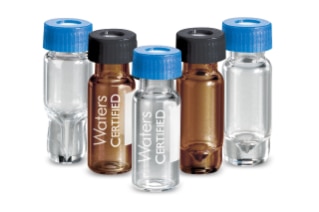Standard & Certified Sample Vials
Maximize lab efficiency with fewer failed assays and lower instrument downtime
Reducing failed assays from unknown contaminant peaks and limiting instrument downtime from out of specification vials or septa is a priority for your lab. Waters sample vials, caps & septa can help you do just that.
Quality controlled via a multi-step certification process, we ensure that Waters Certified vials meet and maintain specified levels of cleanliness, glass surface properties, controlled pH shifts and adsorptive losses - from batch to batch and vial to vial. Choosing the right sample vial for small and large molecule HPLC or UHPLC applications for UV and MS can help meeting the business demand of your laboratory and the requirement of delivering the result with the best quality needed for your analysis.
Specifications
Overview
- Available in LC-GC, LC-MS, and TruView pH Control LCMS Certified Vials with cleanliness tested by UPLC-UV and MS
- Consistent vial-to-vial and lot-to-lot performance
- High recovery vials for limited sample volumes
- Compatible with all autosamplers and designed to fit a range of caps
- Complete selection of vial sizes and materials with combination packs for easy ordering
- Reduced analyte peak variability for results you can rely on
Recommended Use: To reduce risk for your LC analysis while increasing consistency and reproducibility.
Which vial is right for your lab?
-
Application: Glass for basic and legacy methods. Polypropylene where glass is not applicable.
-
Benefit: Low cost, high value.
-
Certification test: Dimensional consistency
-
Application: Routine QC LC-UV analysis of compounds in µg/mL concentrations.
-
Benefit: No UV interference caused by manufacturing and packaging residues of glass and septum.
-
Certification test: UPLC-UV at 195 nm, dimensional consistency
-
Application: Routine QC and LC-MS analysis with lower analyte concentrations from 10-100s ng/mL.
-
Benefit: Low MS interference of known residues and polymers from glass and septum manufacturing.
-
Certification test: LC-MS cleanliness; LC-UV cleanliness; dimensional consistency
-
Application: LC-MS and routine QC analysis and quantification for pH-sensitive compounds and unbuffered dilluents; reduced adsorption of polar bases with high vial-to-vial consistency
-
Benefit: Enhanced glass surface to reduce leaching of Na and other metal ions into solution with a high level of consistency; reduced adsorption effects. Lowest MS interference of residues and polymers from glass and septum manufacturing
-
Certification test: UPLC-UV at 195 nm, pH Control, MS Analyte adsorption and MS scan for cleanliness, dimensional consistency
Control data quality risks and reduce unexpected or ghost peaks
Don’t let the presence of background noise impact your results, causing data quality risks and unexpected or ghost peaks. Background noise can come from many factors. One of the most important factors are vial and septa cleanliness, which introduces contamination peaks. Ghost peaks are introduced by analyte degradation that can be triggered by significant pH changes in the diluent. In this chromatogram, the top shows normal behavior, and the bottom chromatogram shows ghost peaks.
Waters Certified vials are cleanliness tested so you don’t have to worry about contaminant peaks. The TruView pH Control Vials are certified to minimize and control a pH shift away from the neutral.
More time on development. Less on troubleshooting.
Stop losing valuable development time on troubleshooting due to analyte loss from non-specific adsorption. Waters TruView pH Control LCMS Certified Vials have the lowest adsorptive losses on the market, and you can rely on them to provide consistency from batch to batch and vial to vial. This chromatogram shows a comparison of adsorptive loss of chlorhexidine in a variety of vials.
Ideal for demanding MS work
LCMS Certified Vials are suited for analyte concentrations in the 100s ng/mL concentration. Waters LCMS Certified Vials are tested by MS scans from 250 to 1000 m/z with specifications set on the total ion count and presence of clusters in the high mass range. This chromatogram shows a comparison of typical MS scans of Waters LCMS Certified Vials to vials of other sources and clean solvents.
